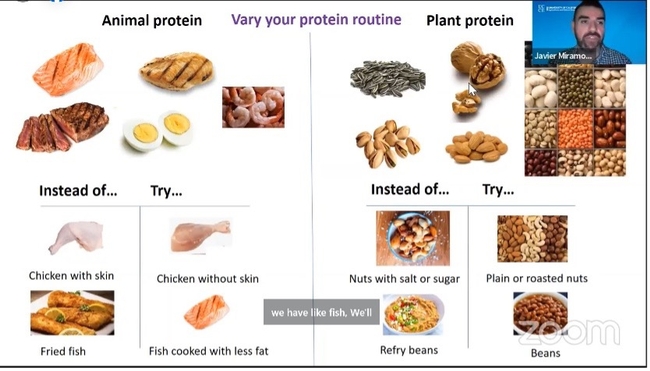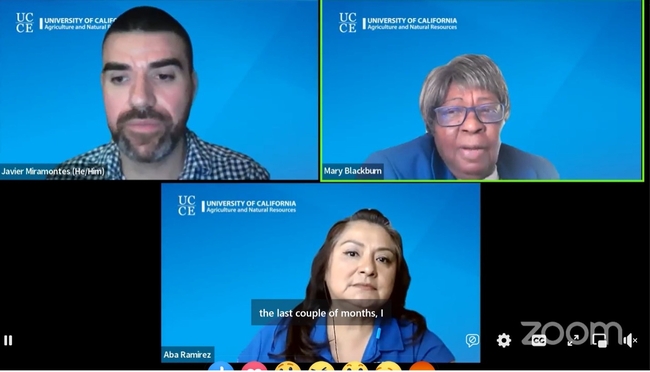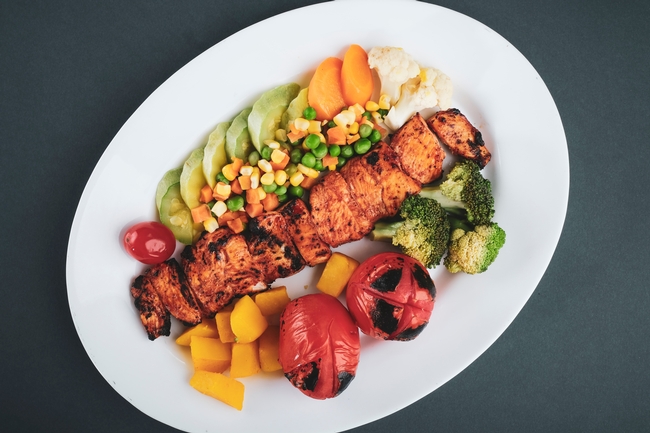Facebook Live highlights ways to find healthy foods that work for your body
Half of our plates should be made up of fruits and vegetables for a healthy diet, according to nutrition experts at UC ANR. Photo by Sam Moqadam, Unsplash
UC Agriculture and Natural Resources recently hosted a Facebook live nutrition webinar on how to find healthy food options that fit your lifestyle. During the lunch break on April 7, participants heard from three nutrition experts from UC ANR:
The conversation began with Miramontes and Ramirez discussing the MyPlate nutrition plan, in which participants balance each meal with portions from each food group.
"Half your plate should be fruits and vegetables, but that's not a one-size-fits-all solution because kids and adults need different amounts of these foods," Ramirez says.
p>The nutrition educators then highlighted which choices from each of the food groups are healthier choices than others.
"When choosing a protein source, be sure to look for lower fat meat options (i.e. grilled chicken instead of fried chicken) to reduce calorie intake ", Miramontes said. "Or try unsalted rather than salted nuts to reduce processed foods and sodium intake."

Nutrition Educator Javier Miramontes discussed protein food choices for your best overall health.
As a follow-up, Blackburn addressed the tensions between healthy eating and individuals' food intolerances and food allergies.
“A food allergy is when a food activates the immune system of the person, whereas a food intolerance means that someone will have difficulty digesting a food,” she explained.< /p>
People can have intolerances to foods from all MyPlate groups, including foods such as whole wheat bread, peanuts, and tomatoes. This problem appears to be a growing problem, as Blackburn noted that "every year we see the number of cases (of food intolerance) increase and the number of foods in these categories increase."
“We have to take matters into our own hands,” Blackburn continued, “by selectively choosing foods and seeing how our bodies respond; if you find yourself constantly bloated after consuming a meal, it may be best to limit your intake. one of these foods for a while and then see how your body responds."
Blackburn described how individuals - by becoming the scientists of their own bodies - can experiment with adding and removing different foods and seeing how their bodies react.

Clockwise from left, Javier Miramontes, Mary Blackburn and Aba Ramirez. Nutrition educators answered questions from audience members at the end of the presentation.
Audience members were invited to ask the speakers questions and learn more about what they could do to achieve their own healthy eating and nutrition goals.
A full recording of the webinar with subtitles is available on Facebook. To date, the video has been viewed over 23,000 times. Look for future UC ANR Facebook Lives on the UC ANR Facebook page that highlight the great work extension educators in California are doing.
Area of Interest Tags: Food
Tags: Aba Ramirez (1), Javier Miramontes (2), Mary Blackburn (4), Nutrition (130)


Half of our plates should be made up of fruits and vegetables for a healthy diet, according to nutrition experts at UC ANR. Photo by Sam Moqadam, Unsplash
UC Agriculture and Natural Resources recently hosted a Facebook live nutrition webinar on how to find healthy food options that fit your lifestyle. During the lunch break on April 7, participants heard from three nutrition experts from UC ANR:
The conversation began with Miramontes and Ramirez discussing the MyPlate nutrition plan, in which participants balance each meal with portions from each food group.
"Half your plate should be fruits and vegetables, but that's not a one-size-fits-all solution because kids and adults need different amounts of these foods," Ramirez says.
p>The nutrition educators then highlighted which choices from each of the food groups are healthier choices than others.
"When choosing a protein source, be sure to look for lower fat meat options (i.e. grilled chicken instead of fried chicken) to reduce calorie intake ", Miramontes said. "Or try unsalted rather than salted nuts to reduce processed foods and sodium intake."

Nutrition Educator Javier Miramontes discussed protein food choices for your best overall health.
As a follow-up, Blackburn addressed the tensions between healthy eating and individuals' food intolerances and food allergies.
“A food allergy is when a food activates the immune system of the person, whereas a food intolerance means that someone will have difficulty digesting a food,” she explained.< /p>
People can have intolerances to foods from all MyPlate groups, including foods such as whole wheat bread, peanuts, and tomatoes. This problem appears to be a growing problem, as Blackburn noted that "every year we see the number of cases (of food intolerance) increase and the number of foods in these categories increase."
“We have to take matters into our own hands,” Blackburn continued, “by selectively choosing foods and seeing how our bodies respond; if you find yourself constantly bloated after consuming a meal, it may be best to limit your intake. one of these foods for a while and then see how your body responds."
Blackburn described how individuals - by becoming the scientists of their own bodies - can experiment with adding and removing different foods and seeing how their bodies react.

Clockwise from left, Javier Miramontes, Mary Blackburn and Aba Ramirez. Nutrition educators answered questions from audience members at the end of the presentation.
Audience members were invited to ask the speakers questions and learn more about what they could do to achieve their own healthy eating and nutrition goals.
A full recording of the webinar with subtitles is available on Facebook. To date, the video has been viewed over 23,000 times. Look for future UC ANR Facebook Lives on the UC ANR Facebook page that highlight the great work extension educators in California are doing.
Area of Interest Tags: Food
Tags: Aba Ramirez (1), Javier Miramontes (2), Mary Blackburn (4), Nutrition (130)
What's Your Reaction?














![Three of ID's top PR executives quit ad firm Powerhouse [EXCLUSIVE]](https://variety.com/wp-content/uploads/2023/02/ID-PR-Logo.jpg?#)







